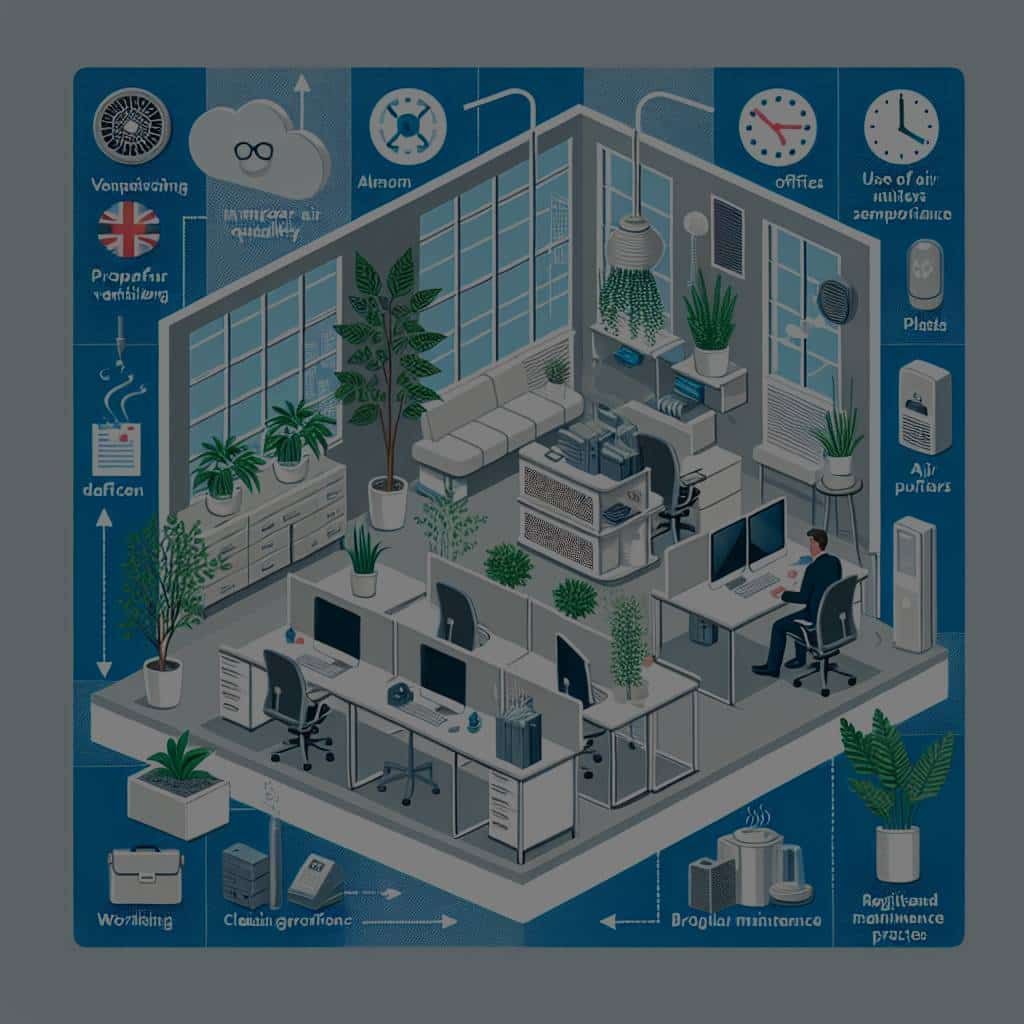What Are the Strategies for Improving Indoor Air Quality in UK Office Spaces?

Air quality often escapes the attention of people because it’s not something that can be perceived readily. Yet, poor indoor air quality (IAQ) can have significant consequences on health and productivity in the workplace. This article will elucidate the current state of IAQ in UK office buildings and provide practical strategies to improve it. As we delve into the subject, we will look at the role air filters, proper ventilation, regular cleaning, data monitoring, and reduction of pollutants play in ensuring a healthy, productive workspace.
Understanding Indoor Air Quality and its Importance
Indoor air quality refers to the air quality within and around buildings and structures, especially as it relates to the health and comfort of building occupants. It’s crucial to understand that the quality of air within office buildings can be up to five times more polluted than outdoor air. This pollution often comes from sources like mould, dust, chemical cleaners, and office equipment.
En parallèle : How Can UK Restaurants Maximize Profit with Dynamic Menu Pricing?
Poor IAQ can lead to health issues, including headaches, fatigue, shortness of breath, hypersensitivity and allergies, sinus congestion, coughing and sneezing, dizziness, and nausea. These health issues can hamper productivity and increase sick days, thereby affecting an organization’s efficiency. Thus, improving indoor air quality in offices is not just about creating a comfortable workspace, it’s about safeguarding employee health and enhancing productivity.
Optimizing Ventilation Systems
One of the key strategies in improving IAQ in office buildings is to optimize the ventilation system. Ventilation systems are designed to control the amount of fresh air that enters the building and remove stale indoor air. However, when improperly maintained or operated, they could circulate dust, mould, and other pollutants within the office.
Avez-vous vu cela : How Can UK Independent Bookstores Thrive with Community-Focused Events?
Regular maintenance of ventilation systems is needed to ensure they are functioning optimally. Filters should be changed regularly to prevent dust build-up and the growth of mould and bacteria. Additionally, ventilation rates should be adjusted to suit the number of people in the office and the activities being carried out.
A well-maintained ventilation system will not only improve IAQ but also help control humidity levels, reducing the risk of mould growth.
Implementing Regular and Thorough Cleaning Practices
Cleaning in an office setting involves more than just dusting and vacuuming. It’s about eliminating sources of pollutants and maintaining a clean, hygienic environment. Regular, thorough cleaning can significantly improve IAQ by removing pollutants such as dust, mould and bacteria.
When implementing a cleaning regimen, it’s important to use cleaning products that do not emit harmful chemicals. Opt for products that are labelled non-toxic or green. Also, consider integrating high-efficiency particulate air (HEPA) vacuums into your cleaning regimen, as they are better at trapping small particles compared to regular vacuums.
Regular cleaning of office equipment, including printers and computers, will also help reduce pollutant levels in the air. These devices tend to gather dust, which can be released into the air during operation.
Using Air Filters and Air Cleaners
Air filters and cleaners play a crucial role in improving IAQ. They work by trapping and removing pollutants from the air. When selecting an air filter or cleaner, it’s important to consider its efficiency in removing different types of pollutants and its fit with your ventilation system.
Air cleaners, such as air purifiers, can be used as an additional measure to improve IAQ. These devices use various technologies, including HEPA filters, activated carbon filters, and ultraviolet germicidal irradiation, to reduce pollutant levels in the air.
However, while air filters and cleaners can help improve IAQ, they should not replace other strategies such as proper ventilation and regular cleaning.
Monitoring Indoor Air Quality
Monitoring indoor air quality is a proactive measure to ensure a healthy and productive workplace. There are various tools available today that can measure key IAQ parameters, including levels of pollutants, temperature, and humidity.
By continually monitoring these parameters, you can gather crucial data that will help you understand the IAQ in your office and identify potential issues. Once identified, these issues can be addressed promptly.
Data from IAQ monitoring can also guide decisions about necessary adjustments to ventilation rates, cleaning schedules, and other IAQ improvement strategies. This data-driven approach will ensure a systematic and effective way to improve and maintain good IAQ in your office.
Remember, the quality of air in your office environment is a key factor affecting the health and productivity of your employees. By implementing these strategies, you will be taking a significant step towards improving your workplace’s indoor air quality. The investment of time and resources will surely yield dividends in the form of healthier, happier, and more productive employees.
Reducing Sources of Pollutants
Reducing the sources of pollutants in office spaces is a highly effective way to improve the indoor air quality. These pollutants include volatile organic compounds (VOCs) from office supplies, particulate matter from fabrics, and fumes from cleaning products.
Companies can implement several measures to minimize these pollutants. For instance, opting for office supplies and equipment with lower VOC emissions. Ensure that office equipment, such as printers and photocopiers, are placed in well-ventilated areas as they can emit particulate matter and chemicals when in use.
Moreover, consider using less toxic cleaning products. Many cleaning products contain harsh chemicals that can contribute to poor indoor air quality. Select cleaning products that are low in VOCs and fragrances, and remember to follow the manufacturer’s instructions to avoid overuse.
Additionally, office furniture and furnishings should be chosen with care. They can release pollutants such as formaldehyde into the office environment. Therefore, when choosing furniture, look for those that are labelled low-VOC or green guard certified.
Also, smoking should be strictly prohibited inside office buildings, as it leads to significant indoor air pollution.
By taking these steps to reduce sources of pollutants, companies can significantly improve the indoor air quality in their office spaces.
Incorporating Plants into Office Spaces
Incorporating plants into office spaces is another effective strategy for improving indoor air quality. Plants are natural air purifiers. They absorb carbon dioxide and release oxygen into the air. Furthermore, they can absorb harmful chemicals, including volatile organic compounds, improving the quality of indoor air.
Plants such as spider plants, Boston ferns, and snake plants are known for their excellent air-purifying qualities. They are easy to care for and thrive in office conditions.
However, it’s important to note that while having plants in the office can help improve air quality, they should be properly cared for to prevent mould growth and insect infestations, which can negatively impact indoor air quality.
Therefore, it’s crucial to ensure the plants are regularly watered and pruned, and the plant pots and surrounding areas are kept clean.
By incorporating plants into office spaces, not only can companies improve indoor air quality, but they can also enhance the aesthetic appeal of the workplace.
Concluding Thoughts
Improving indoor air quality in UK office spaces is a multifaceted process that requires ongoing effort and commitment. From optimizing ventilation systems, implementing regular cleaning practices, using air filters and cleaners, monitoring indoor air quality to reducing sources of pollutants and incorporating plants, each strategy plays a crucial role in improving the health, safety and productivity of employees.
Investing in these strategies is not just an investment in the physical space of an office, but also an investment in the people who work there. The benefits of improved indoor air quality extend beyond physical health, impacting mental wellbeing, productivity, and overall job satisfaction.
Therefore, it is imperative for companies to take indoor air quality seriously and implement these strategies to ensure a healthy, comfortable, and productive work environment. Remember, our environment shapes us just as much as we shape it. By prioritizing indoor air quality, companies will be creating an environment where their employees can thrive.
